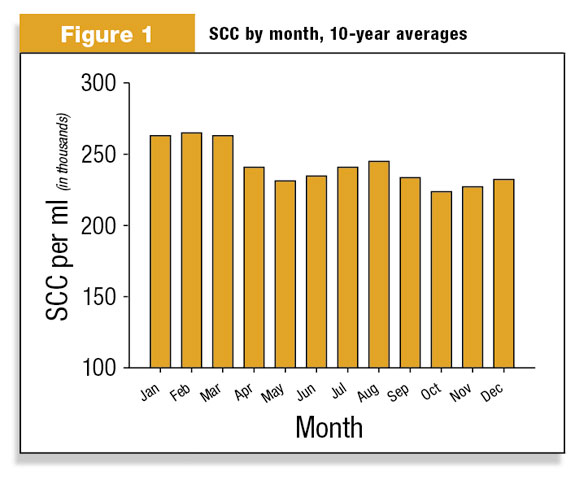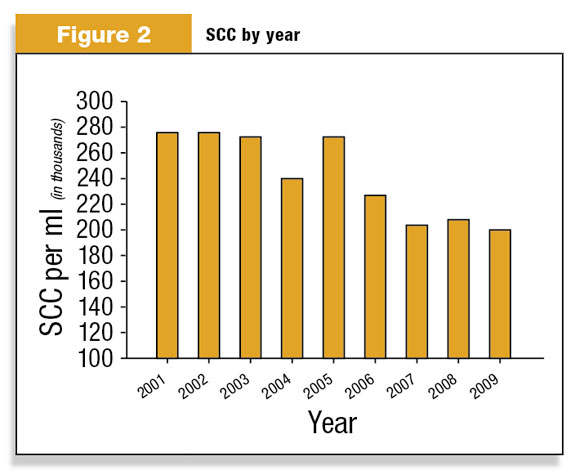Starting in 2011, the somatic cell count (SCC) in bulk tank milk (BTM) must be less than 400,000 cells per ml for milk or milk products exported to the European Union (EU). Most milk in California is marketed by cooperatives, and nearly all of them or their customers are exporting milk to the EU. This means all dairies are ultimately affected. How difficult is it to achieve SCC less than 400,000, and are we up to the challenge?

What influences BTM SCC levels?
We summarized BTM data from nearly 700 dairies during a 10-year period from 2000 to 2009. There is a seasonal pattern of SCC in California – highest in winter, lowest in spring and fall, and up slightly in mid-summer ( Figure 1 ).
This pattern appears to be related to weather conditions.
Highest SCC in winter reflects wet conditions in corrals during the brief rainy season. In most areas there is little rain from April to October.
Cows are cleaner in dry environments, keeping SCC low. So why does SCC rise in summer? Cows seek relief from intense heat in summer.
They crowd under shades, creating moisture and high bacterial loads where they rest.
Water from misters used for cooling may drift onto freestalls or corrals, contributing to higher moisture – and higher SCC.

Figure 2 shows SCC by year. There is a trend for lower SCC over the 10-year period. The year 2005 is an exception.
We speculate higher SCC that year may be attributed to very high milk prices in 2004 and 2005.
Dairy producers may have kept cows in the herd that should have been culled in order to ship as much milk as possible.
If we blame high milk prices for higher SCC in 2005, then how do we explain 2007, when milk prices were also high?
Limits on milk production by dairy cooperatives, as well as new environmental regulations, motivated dairies to cull heavily, resulting in lower SCC.
Persistent constraints on expansion and economic crisis in the dairy sector have contributed to a continued trend for lower SCC, under 200,000 in 2009.
How does SCC relate to milk yield and reproductive performance?
To evaluate the relationship of SCC with various herd management parameters, we summarized DHIA data for California herds in 2009. We looked at milk yield per cow for herds in four SCC categories.
Herds with the lowest SCC had 2357 lbs more milk per cow than those over 250,000, and 4170 lbs more than those over 400,000 SCC. Milk yield goes down when SCC goes up, a fact that has been known for decades.
We also looked at the calving interval (CI) for the same four SCC categories. Again, we saw that herds with low SCC perform much better than those with higher SCC.
The CI for the lowest SCC group is 1.75 months shorter than the CI for herds over 400,000 SCC. This is no surprise – research has shown mastitis reduces reproductive performance.
What are the implications for high-SCC herds?
Rigorous regulatory standards and quality bonuses (or penalties) have motivated most producers to keep SCC low for years.
The percentage of dairies with SCC over 400,000 is only 3 percent when we look at 12-month averages from dairy cooperative BTM samples or the DHIA rolling herd average.
A greater number will exceed this level for a day, a week, a month or longer. We calculated the percentage of herds from October 2008 to September 2009 that exceeded 400,000 SCC in BTM on at least one occasion.
In January, over 25 percent of herds had a high SCC tank. Clearly, the rainy season is the time of highest risk.
Dairies over 400,000 SCC will face stiff penalties for poor quality, as well as higher costs for segregating and marketing their milk separately from milk that will be exported. They could even risk losing a home for their milk.
How can you keep SCC low?
Many management practices are important for maintaining a low SCC. The overwhelming evidence from California BTM data showing a connection between winter season and elevated SCC strongly suggests that housing management should be your first priority.
Prepare for winter. Get bedding ready for the first big rain event. Dry lots (open corrals) are not dry in winter, and cows need a dry place to lie down. Wet, sloppy conditions result in filthy cows and you simply cannot wash your way out of high SCC.
Elevated SCC in milk is an indication of inflammation or mastitis. Bacteria that cause these conditions thrive in crowded, dirty housing areas. Reduce the risk by careful grooming of corrals and freestalls to provide dry conditions so cows stay clean – in winter and summer.
High-quality, low-SCC milk is achievable – but low-moisture housing and clean cows are essential. Healthier, more productive cows and increased profits will reward you for the effort.
How does SCC in California compare to other areas of the U.S.?
Every year, the U.S. Department of Agriculture monitors bulk tank SCC in federal milk marketing orders. California is not included in this data because it is not in a federal marketing order.
We plotted our California SCC data with the USDA data from several western states from 2001 to 2009. California’s milk has been “the best in the West” for the last few years. PD
—Excerpts from University of California Agriculture and Natural Resources California Dairy Newsletter, Vol. 2, Issue 5; November 2010.






